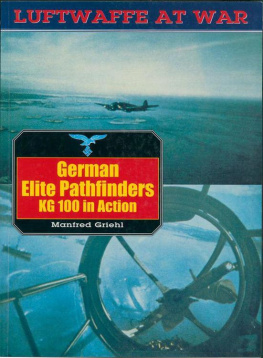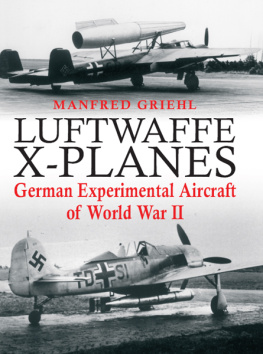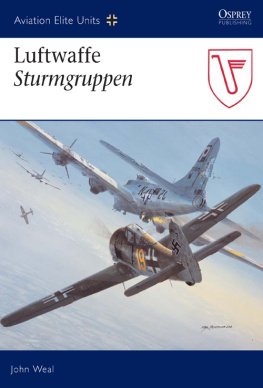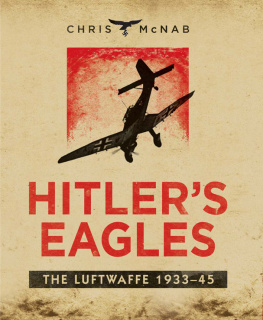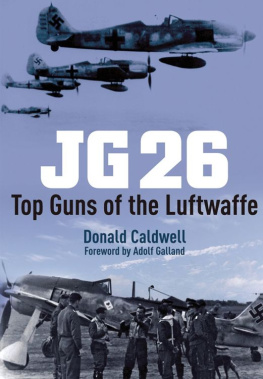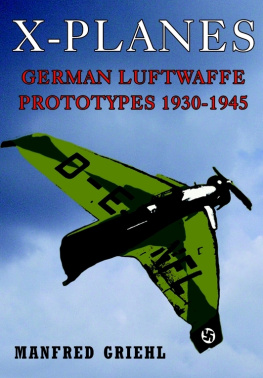

Sometimes no special cranes were available to lift aircraft and the black men (the ground crew, whose nickname came from their all-black attire) had to do it by muscle power alone as seen here. They are lifting the rear fuselage of one of their He Ills. In the background, to the left, is a Ju 52 used to transport spare parts and equipment to keep the unit operational.


Manfred Griehl

Frontline Books

German Elite Pathfinders: KG 100 in action
First published 2000 by Greenhill Books
published in this format in 2015 by
Frontline Books
an imprint of
Pen & Sword Books Ltd
47 Church Street, Barnsley, S70 2AS
www.frontline-books.com
Copyright Manfred Griehl
The moral right of the author has been asserted.
All rights reserved. No part of this publication may be reproduced, stored in a retrieval system or transmitted in any form or by any means, electronic, mechanical or otherwise without the written permission of the Publisher.
British Library Cataloguing in Publication Data Griehl, Manfred
German elite pathfinders: KG 100 in action. - (Luftwaffe at war)
1. Germany. Luftwaffe. Kampfgruppe 100 - History
2. World War, 19391945 Aerial operations, German
3. World War, 19391945 Regimental histories Germany
I. Title
940.544943
ISBN 1-85367-424-9
Library of Congress Cataloging-in-Publication Data available
Designed by DAG Publications
Ltd Design by David Gibbons
Layout by Anthony A. Evans
Printed in Singapore
LUFTWAFFE AT WAR
GERMAN ELITE PATHFINDERS KG 100 IN ACTION
Early in 1934 the Secretary of Aviation, Erhard Milch, ordered Dr Plendl to begin the development of a secret navigation system called X- Verfahren (the X-system). As a radio-beam navigation aid, this would allow German bomber crews to locate distant targets by day or night, irrespective of the weather. The research work was carried out by a department of the Deutsche Versuchsanstalt fr Luftfahrt or DVL (the German Aviation Experimental Institute), which worked with the Erprobungsstelle der Luftwaffe (Luftwaffe Test Establishment) based at Rechlin on Lake Mritz. By December 1935 it was possible to navigate over distances of some 550 km flying at an altitude of 6000 m. First trials were carried out with a Ju 52/3m (D-ADEH) whose crew succeeded in bombing an area of 90,000m in central Germany. From 1 May 1935 all experimental work on the X-beam system was taken over by the E-Stelle at Rechlin. An experimental unit was established, comprising Ju 52/3m aircraft fitted with the new system. From 1935 to 1940 some thirty X-Sendestationen (X-beam transmitting stations) were installed all over Germany to allow further operations over eastern and western Europe.
By 1 November 1937 the Luftnachrichtenschule und Versuchsregiment (Air Signals Training and Experimental Regiment) was established at Kothen but was not part of the Heeres Nachrichtenschule (Army Signals School). All units belonging to the regiment, commanded by Oberstleutnant Heinrich Aschenbrenner, became operational by early December. On 1 January 1938 the experimental unit of the regiment, 7/LnSchule und Versuchsregiment, led by Oberleutnant Hermann Schmidt, was equipped with twelve Ju 52s. The crews carried out several long-range missions to the Canary Islands and to Tripoli in North Africa.
During summer 1938 the Luftwaffe established a Flugfunkerschule und Versuchskommando (Radio Operators Training and Experimental Command), renamed the Luftnachrichtenabteilung 100, or LnAbt 100, (Air Signals Detachment 100) on 26 August that year. In the autumn it received its first Do 17U Fhrungsmaschinen (literally leader-machines, or pathfinders) but due to its narrow fuselage it was impossible to install the X-beam system in the Dornier. After a training phase the LnAbt 100 took part in the Poland campaign. The first operational mission was carried out on the night of 3/4 September to a target near the small town of Palmiry. On 18 November 1939, following the occupation of Poland the unit was renamed Kampfgruppe 100 (KGr 100) Wiking. As an independent unit, Wiking was known solely by the abbreviation KGr 100, whereas most Kampfgruppen names simply took the form of Roman numeral prefixes which preceded the parent Kampfgeschwader (KG) number. KGr 100 was not initially a subdivision of any of the existing Geschwader, though it was later to form part of a new parent unit (see below). After its formation, KGr 100 left the Luftnachrichtentruppe (Air Signals Branch) and became a real combat unit. An unarmed X-beam mission, ordered by the Fhrer, was carried out on 20 December 1939 under the command of Oberleutnant Schmidt whose crew was sent to the British capital to check the security of the X-beam system over large distances. Early in January 1940 only one Do 17 and one He 111 belonged to the Stab (staff) of KGr 100. Both of KGr 100s Staffeln were equipped with He lllHs. Of twenty-four bombers only thirteen were ready for action over Western Europe in early 1940.
The unit operated against enemy vessels on the North Sea between January 1940 and the early summer, and took part in the Norwegian campaign of that year. Under the command of Luftflottenkommando 5 (led by Generaloberst Milch) KGr 100 was sent out to destroy Norwegian anti-aircraft positions and coastal batteries. The unit was also used for anti-submarine and anti-shipping missions near the Norwegian coast.
During summer 1940 the first new He 111H-3 fitted with X-beam equipment (X- Gert ) arrived at Lneburg. From there the Gruppe was transferred to Vannes in Brittany where more than five X-beam radio stations had been installed in order to intensify the air war over Britain. The first pathfinder missions over Britain took place during August 1940. Twenty aircraft of Kampfgruppe 100 targeted the Nuffield factory in Birmingham with the help of the X-beam. The unit was subsequently used to lead bombing raids on targets all over the British Isles. Long-range missions to Liverpool and Glasgow were carried out between December 1940 and April 1941. Crews of KGr 100 took part in the last heavy attack on London on the night of 11/12 May 1941. Some crews belonging to the Kampfgruppe were engaged in raids on shipping targets and on ports along the southern coast Britain. Armed reconnaissance missions were carried out in June and July 1941.
After the German attempt to besiege the British Isles with the Luftwaffe and minor forces of the Kriegsmarine failed, Kampfgruppe 100 was transferred to Terespol behind the Eastern Front where the unit was used to assist the Luftwaffe to attack the Russian capital. Together with KG 28 and parts of KG 4 and KG 26, KGr 100 successfully bombed industrial targets in the Moscow area. In 1942 KGr 100 operated over the southern part of the Eastern Front where it was engaged in several costly missions up to 1943.
On 29 November 1941, Kampfgeschwader 100 (KG 100) Wiking was established from KGr 100 and other units. It took the form of a well-equipped He 111 unit divided into a Geschwaderstab with four flying Kampfgruppen. One of the Gruppen under the command of the newly created KG 100 was the former Ergnzungsstaffel (replacement squadron) of KGr 100. It was designated as IV/KG 100 Wiking and retained its original role of Ergnzungsstaffel until 20 August 1944.
Next page
